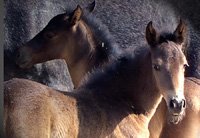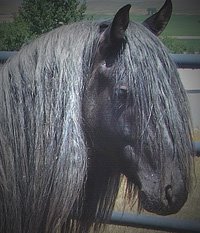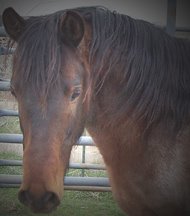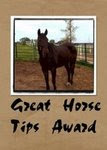What, nobody?
Humph. You win. This morning, I wrapped my ankle six ways to Sunday and headed out to the round corral.
 I started with Aaruba's workout because his training is sufficiently advanced that occasional failures on my part don't affect him as much as they would a greener horse. I knew that if my ankle failed, Aaruba would merely stop and give me an inquisitive look, rather than drawing some unintended conclusion.
I started with Aaruba's workout because his training is sufficiently advanced that occasional failures on my part don't affect him as much as they would a greener horse. I knew that if my ankle failed, Aaruba would merely stop and give me an inquisitive look, rather than drawing some unintended conclusion.He was thrilled to be moving again after a week of paddock-induced boredom, and though I typically keep him to a trot for these workouts, this time I gave in to a bit of cantering. Despite being stiff and a bit clumsy, my ankle held up through the basic steps of our liberty "dance," which was good enough for me.
I caught Acey next, so Travis could work on her feet. One of the frustrating limitations of not having a covered round corral is that winter weather puts a halt to almost all work with the Barbs. They came to me entirely ungentled, and their training hasn't yet progressed to the point that I can always be sure of pulling them straight out of the paddock and asking for obedience without first doing a bit of remedial groundwork.
 Any decent trainer knows that one of the linchpins of training is review. When we teach a horse to pick up its feet, for example, we start by getting said horse accustomed to having a rope dangled around his legs. Depending on the individual, that might be enough for one lesson. The next day, we review dangling the rope, then begin wrapping the rope around one leg at a time until the horse accepts that sensation. The next day, we dangle the rope, then wrap it, then coil it around the fetlock and give an upward tug. As soon as the horse shifts his weight as if to lift the foot, we stop tugging. Before long, the horse figures out what we want by receiving a reward (the release of pressure) for progress in the right direction. Each day, we review the early steps but reduce the amount of time spent on them, until the horse is so comfortable with the request that review is no longer needed.
Any decent trainer knows that one of the linchpins of training is review. When we teach a horse to pick up its feet, for example, we start by getting said horse accustomed to having a rope dangled around his legs. Depending on the individual, that might be enough for one lesson. The next day, we review dangling the rope, then begin wrapping the rope around one leg at a time until the horse accepts that sensation. The next day, we dangle the rope, then wrap it, then coil it around the fetlock and give an upward tug. As soon as the horse shifts his weight as if to lift the foot, we stop tugging. Before long, the horse figures out what we want by receiving a reward (the release of pressure) for progress in the right direction. Each day, we review the early steps but reduce the amount of time spent on them, until the horse is so comfortable with the request that review is no longer needed.Unfortunately, lack of a safe training area often prevents review of basic lessons. Although the hoof-lifting lessons described above don't appear to involve movement, they very well might, particularly early on or after a long hiatus. This is because "discipline" often takes the form of motion. For example, if the horse wants to spook and run away from the dangling rope, fine, that's his choice. But he's going to have to trot around a few times. He'll learn quickly that it's easier to stand and deal with the dangling rope than to do laps.
 All that is to explain why Acey was in such desperate need of a hoof trim. She had her last trim at the end of November, just before the bad weather set in. Ice, mud, and snow kept us from doing the critical review lessons that would have led to a safe re-trim until now.
All that is to explain why Acey was in such desperate need of a hoof trim. She had her last trim at the end of November, just before the bad weather set in. Ice, mud, and snow kept us from doing the critical review lessons that would have led to a safe re-trim until now.I'm pleased to report that she remembered her lessons and behaved like an angel, even when Travis knelt to finish with a mustang roll. Kneeling like this is not a particularly safe technique, nor one I'd recommend even if your trimmer, like mine, is a good bit taller than your horse. Nevertheless, it's nice to know that Acey's groundwork is solid enough that it didn't cause me any heartburn.
Seeing as my ankle was still going strong after Acey's trim, I went on to work with Consolation, CJ, and Ripple. Now, after a week of frustration, I have ice on my sprain (which aches a bit from the effort) but a smile on my face. Longfellow would be proud.









No comments:
Post a Comment